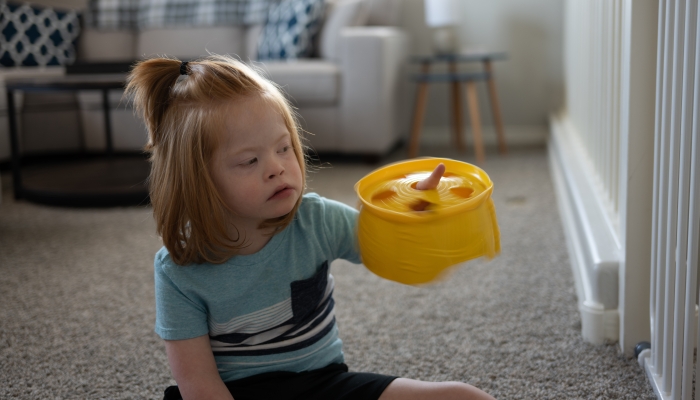Managing Repetitive or Stereotyped Behavior in Autism

This post may contain affiliate links; please see our terms of use for details.
- Stereotyped or repetitive behavior is a key indicator of autism.
- There are four types of repetitive behavior: Motor, vocal, self-injurious, and other behavioral movements.
- Trying to stop repetitive behavior can make it worse.
- Management is possible with specific interventions.
In 1943, the first case of autism was diagnosed. Since then, what we know about autism has grown exponentially, and so has the number of people diagnosed with Autism Spectrum Disorder.
According to data collected by the CDC:
- Some form of the disorder affects 1 in every 44 children.
- Boys are four times more likely to be diagnosed with ASD than girls.
- Autism is found in every racial, socioeconomic, and cultural group.
We’ve also learned that early intervention provides a lifelong impact on social and emotional development for those diagnosed with autism. When help, education, and understanding are given to a child with autism, they have a much higher likelihood of reaching their fullest potential.
A vital component of intervention is learning how to manage repetitive or stereotyped behavior.
In this article, you’ll learn what motivates repetitive behaviors, the significance of the behaviors, and the most effective ways to manage and embrace repetitive or stereotypic behaviors.
Stereotyped Behavior in Autism: What Is It?
According to The Diagnostic and Statistical Manual by the American Psychiatric Association, Fifth Edition (DSM-5), one of three core diagnostic features of autism spectrum disorder is restricted, repetitive, and stereotyped patterns of behavior.
While wide-ranging, these stereotypic behaviors are the most commonly known indicator of an ASD diagnosis. They include repetitive movements, self-injurious behavior, and repetitive non-functional speech, also referred to as echolalia.
However, stereotypic behavior, also known as stimming, is quite common among all people, neurotypical and neurodiverse alike!
You may fidget when you are trying to pay attention or bounce your leg when you are nervous. Fidgeting may seem purposeless, but in fact, it can calm a person or help them focus.
Such is the case in all the stereotyped behaviors within Autism Spectrum Disorder.
Examples of Stereotyped Behaviors
In the article Rethinking Stereotypies in Autism published in Seminars in Pediatric Neurology, authors Meredith J. McCarty, BSA, and Audrey C. Brumback, MD, PhD, define four types of stereotypy.
| Types of stereotypy | Examples |
| Motor stereotypies are the “non-goal-directed, rhythmic, repetitive movements that stop with distraction.” |
|
| Self-injurious behaviors are “the intentional, direct injuring of body tissue without suicidal intent.” |
|
| Vocal stereotypy is “atypical use of language or nonfunctional speech.” |
|
| Stereotyped movement is a “non-functional repetitive behavior.” |
|

Do Stereotyped Behaviors Always Indicate Autism?
To be diagnosed with Autism, a child must exhibit stereotypic behaviors. However, exhibiting stereotypic behaviors does not automatically indicate autism.
Nail biting, foot tapping, leg bouncing, finger tapping, and pacing are all motor stereotypy generally accepted by society as “normal” anxious behavior. These physically repetitious movements are not a result of anxiety but the brain’s effort to soothe, stimulate, or process.
Stereotypic behaviors are also commonplace in individuals with some sensory, intellectual, or developmental disabilities. Sometimes different types of developmental delays or mental disorders can show these behaviors also, but they typically are temporary causes, such as a medication side effect.
What Causes Stereotyped Behavior in Children with Autism?
Children with autism may use stereotyped behavior for multiple reasons. The reasons tend to fit into three different categories.
- Sensory Input: Either over or under stimulation can be the precursor for stimming behavior.
- Emotional Expression: Expressing pain or emotional reactions, both positive and negative.
- Self-Regulation: Regulating or self-soothing due to strong emotions.
According to Chloe Willimas writing for Spectrum News, neurodiverse people have brain activity patterns that differ from those of their neurotypical peers. Much is still unknown about these differences, but most research has shown that autistic children have increased connectivity between two separate brain regions while engaging in repetitive behaviors than the neurotypical population.
Individuals with autism tend to “perceive the world through sensation and action, while most neurotypicals perceive through thought and language,” according to James MacDonald in his book Communicating Partners: 30 Years of Building Responsive Relationships with Late-Talking Children including Autism, Asperger’s Syndrome (ASD), Down Syndrome, and Typical Development.
- MacDonald, James D. (Author)
- English (Publication Language)
- 336 Pages – 05/15/2004 (Publication Date) – Jessica Kingsley Publishers (Publisher)
Repetitive behaviors are a way for those with ASD to cope with the need for more or less sensory stimulation, with emotional issues, and with language barriers.
Repetitive behaviors allow children with autism spectrum disorder to make sense of the world around them, which can often be confusing and scary. They enable them to communicate their needs or feelings when they cannot use the words. It provides them relief from the overwhelming world around them.
Understanding why the behaviors exist is essential before creating a plan to manage them. To generate change, first understand what motivates the behavior and then determine how else your child can meet his needs.
Stereotyped Behaviors: Things to Consider
If your son is flapping his arms or excessively grunting as you walk through the grocery store, it is understandable why you may be asking: “How do I get him to stop?”
Before trying to stop or change his behavior, there are a few things to consider regarding the impact of his self-stimulatory behavior. Ask yourself and other caregivers the following questions:
- Does his behavior negatively impact anyone else in the family or social circle?
- Is his repetitive motor movements interfering with his ability to learn?
- Is he harming himself physically?
- Are his repetitive patterns stopping him from participating in play with others?
- Is this a behavior that will be acceptable when he is an older teen or adult?
- Can he still manage his daily tasks while engaging in the identified behavior?
If you answered “yes” to more than one of the above questions, it might be in the best interest of your son or family to find ways to change or alter his stereotyped behavior.
Instead of asking, “How do I stop him from flapping his arms?” ask yourself, “How can I help this repetitive behavior work for him and not against him?”
How to Manage Stereotyped Behaviors in Autism
Trying to stop repetitive behavior can sometimes lead to more recurring episodes. So instead of eliminating it, the goal is to manage the stereotyped behaviors.
Management looks different depending on the type of stereotyped behavior and the goal. The first step should be visiting your primary care doctor to eliminate any biological reason for the behavior. Migraines, visual problems, toothache, or other physical ailments can affect behaviors. Treating physical pain could be all that is necessary to solve the issue.
Once a doctor has provided your child with a clean bill of health, you can decide on a plan of action for management.

Ideas for Management
There are times when behaviors interfere with learning or interpersonal relationships. This interference may be a reason to work on reducing his stimming behaviors by setting a limit or redirecting him to something more helpful. The following are a few ideas on how to best manage repetitive behaviors.
Set limits on the behavior
Providing some limits to your son can help him learn to keep his repetitive behaviors at a minimum. Perhaps he likes to open and close doors constantly. Setting a limit like, “You can open and close the bedroom door once every hour,” allows him to still engage in the behavior but also encourages some level of self-control.
The critical thing to remember with setting limits is that you have to provide the consistency he needs to stay aware of his boundary. Set a timer to go off once an hour or buy him a watch that will alert him.
Redirect to a more helpful behavior
If he is engaging in some self-injurious behaviors, it can be helpful to redirect him to something more gentle to his body.
“Can you rub your face gently instead of slapping it?”
“I know you like biting your fingers, but they are starting to bleed. Could you try keeping a smooth rock in your pocket and rubbing it with your fingers instead of putting them in your mouth?”
Use visual cues or helpful stories
Since children with autism engage in repetitive behaviors to make sense of their world, providing visual cues or narratives can help process emotions or environmental changes.
Books, educational videos, flashcards, and journaling are alternative ways of processing that will engage his mind more than conversation or formal lessons, especially if visual stimming is present.
“I can tell you are having a lot of big emotions right now. Can you draw me a picture of what’s happening inside you right now?”
“I know it makes you anxious to see your bedroom furniture rearranged. How about we read that book about anxiety together right now?”
“Let’s watch a couple of helpful videos about how to make a friend. Then we can practice what you learn?”
Maintain a strict schedule
A strict, structured schedule is so important to children. Those on the spectrum crave it even more. Predicting what happens next alleviates fears of the unknown and helps provide direction for behavioral expectations. If anxiety is a leading factor for stereotypic behaviors, then offering the comfort of predictability, through a strict schedule and a plan to stay organized, will help your son cope.
“After school, we always sit on the couch and watch a show for an hour. You can look forward to that all day long at school!”
“The plan for the day is written on your bedroom door. Please check it whenever you need a reminder of what’s next.”
Use behaviors as a reward
Using a chosen repetitive behavior as a reward to encourage social play or work is beneficial in two ways. It teaches life skills and also allows some structure around stereotypic behavior.
“Once you’re done with your math homework, you can spin around in circles.”
“Talk to your friend about birds for five minutes and then listen to their interests for five minutes.”
Add props
Suppose sensory overload is a cause of the behavior. In that case, providing some props to help with the overload can significantly decrease his discomfort, thereby removing his need to self-soothe.
“Let’s bring your noise-canceling headphones with us to the store.”
“If the sun feels too bright, you can wear your sunglasses.”
“I brought you an extra pair of socks if yours get too scratchy.”
Professional behavioral interventions
Stereotyped behaviors can also physically harm your child, which is a valid reason to want to discontinue the behavior. In cases where the behavior is very concerning or dangerous, it is important to seek professional intervention as soon as possible.
Psychologists, behavioral interventionists, autism experts, and occupational therapists are all professionals that could offer a functional analysis and insight into how to stop harmful behavior. A quick search of people in your area or a recommendation by your primary care physician can send you in the right direction.
Asking for help and creating a plan for children with autism is a great way to nurture the emotional development of your child. With the right approach and acceptance of the stereotyped behaviors, he can live a happy, well-adjusted life!

Related Posts

Autism
Developing Time Management Skills in Children with Autism: 7 Tips
Learn how you can use structure and visual aids to help your child with autism learn time management skills.

Autism
Occupational Therapy for Children with Autism: How It Can Make a Difference
Children with autism face challenges in many different areas. Occupational therapy can help children address these difficulties while having fun!

Autism, Behavior
OCD vs Autism in Children: How To Tell the Difference
OCD and ASD are fundamentally different, but their symptoms are very similar. Learn how to tell the difference to support your child.
